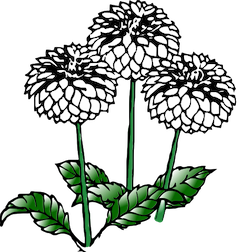 | dahlia society of victoria | LOGIN: |
|
History of the Dahlia |
In 1570, King Phillip II of Spain sent Francisco Hernandez to Mexico to study the natural resources of the country. He described plants that resemble dahlia species under the names Acocotli and Cocoxochitl. The first drawings, made by an associate, were not published until 1651. These botanists discovered the Tree Dahlia (D. imperialis) which has hollow stems that were often used for transporting water. The Aztec name for this dahlia was Acocotli or 'water cane'. Dahlia tubers were grown for food by the Aztecs, but this use largely died out after the Spanish Conquest. Some cultivation in gardens was observed but they seem to have remained wildflowers for the most part. Dahlias do not appear again in historical records until 1789 when the director of the Botanical Garden at Mexico City sent seeds to Abbe Antonio Jose Cavanilles who worked at the Royal Gardens of Madrid. From these he grew three forms, Dahlia pinnata, D. rosea, and D. coccinea. Abbe Cavanilles named the genus after Anders Dahl, a Swedish botanist. New species and hybrids were sent from Mexico to Europe over time. The dahlia's unusual genetics mean distinguishing species and hybrids, many of which occur naturally in the wild, has proved difficult. One botanist gave up and lumped them all into one species, Dahlia variabilis! At least one of the first species taken to Europe, Dahlia pinnata, is thought today to be a hybrid descended from the original D. pinnata, now lost and possibly extinct. Dahlias did not spread quickly, perhaps because they were initially considered mainly as a potential food crop. The first dahlias from Madrid only circulated slowly to other places in Europe. The flowers were not particularly admired although the capacity to hybridise into new forms began to be noted. In the early 19th century the first double forms arrived in Europe. Once breeders discovered the astonishing range of forms that could be produced the flower became very popular. Through the 1800s and 1900s, thousands of new forms were developed, with 14,000 cultivars recognized by 1936. Seeds and tubers were introduced from Europe to the UK in the early 1800s by Lady Holland and others. The Society has been unable to determine when they were introduced to Australia but undoubtedly they first came from Britain. The Carnation, Dahlia and Sweet Pea Society of Victoria was formed in 1901. A history of the society was published in 1919. Several enthusiasts and horticultural professionals are mentioned as founding members of the dahlia section. There must have been interest in and cultivation of the dahlia in Victoria for some time before 1901. Before insulin was discovered in 1923, diabetics and consumptives in Europe and America were often given a substance called Atlantic starch or diabetic sugar derived from inulin, a fruit sugar extracted from dahlia tubers. Dahlias have also been used for dyeing. The dahlia was declared the national flower of Mexico in 1963. It is the official flower of San Francisco and of Seattle in the United States’ North-East where there are large communities of dahlia enthusiasts. The botany of dahlias is still an active area of research. Exploration in Central America continues in search of new species and natural hybrids. Many varieties once considered to be species have been reclassified as hybrids. There are generally thought to be 42 known species and over 50,000 cultivars to which hundreds are added each year. |